|
Displaying items by tag: Cezanne
The future is bright for artists across Europe after politicians announced October 28, they will not enforce a Europe-wide ban on cadmium pigment. The U-turn came following extensive public consultation with artists and paint-makers, who objected to a palette without the golden yellows, fiery oranges and deep maroons created from cadmium and used by masters such as Monet, Cézanne and Munch since the 1840s.
“Poussin and God” is one of a three-part series of exhibitions through which the Musée du Louvre is showcasing the art of the seventeenth century. On show at the museum’s Hall Napoléon through June 29, 2015, “Poussin and God” marks the 350th anniversary of the death of Nicolas Poussin in 1665.
According to the Musée du Louvre, although Poussin is the greatest French painter of the seventeenth century and is considered by some as the greatest of all time, he is less well known today than Watteau, Delacroix, Monet, or Cézanne. The Musée du Louvre is aiming to rectify the situation by proposing a fascinating yet accessible entry point to the work of the great French master.
Contrary to popular opinion, James Abbott McNeill Whistler's famous 1871 painting "Arrangement in Grey and Black No. 1," better known as "Portrait of the Artist's Mother," is not a harsh and puritanical portrayal of a matriarch. It's a homage to the rich and tender relationship shared by a mother and her loving son, says Norton Simon Museum associate curator Emily Beeny.
The painting, made in London while the artist's mother, Anna, was living with him at Cheyne Walk, Chelsea, was the last Whistler would submit to the Royal Academy of Art.
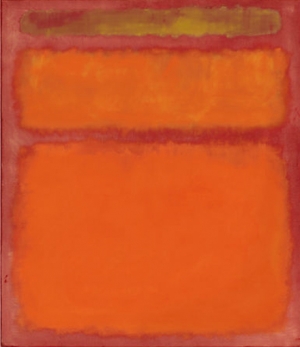
As the world economy began to tank about five years ago, a curious thing happened at the top level of the international art market: It started to boom. At the annual spring art auctions at Sotheby's and Christie's in New York and their branches around the globe, deep-pocketed bidders snapped up Braques and Bacons, Klimts and Kandinskys, often at record prices.
Now with the global recession officially over but the American and European economies still shaky, auction records for blue-chip modern and contemporary art continue to be shattered. Just a few months ago, a pastel version of Edvard Munch’s "The Scream" (1895) fetched an astounding $119.9 million at Sotheby’s, by far the highest price ever paid at auction for a work of art, surpassing the winning bid of $106.5 million for Picasso's "Nude, Green Leaves and Bust" (1932) at Christie’s two years earlier. A week after the gavel fell on the Munch, Mark Rothko's "Orange, Red, Yellow" (1961) went for nearly $87 million, the artist’s personal best at auction.
Sometime next fall, the Alfred Stieglitz collection, Fisk University’s renowned art exhibit, will be packed up into crates and trundled off to Arkansas.
It will stay there for two years as part of a sharing agreement that, until recently, was caught up in what appeared to be an unyielding battle between ownership rights and financial distress.
The university, which has long run a $2 million annual deficit, agreed to sell half ownership rights of its $74 million Alfred Stieglitz collection for $30 million to a museum opened last fall in Bentonville, Ark., controlled by Wal-Mart heiress Alice Walton, according to an agreement filed in Davidson County Chancery Court.
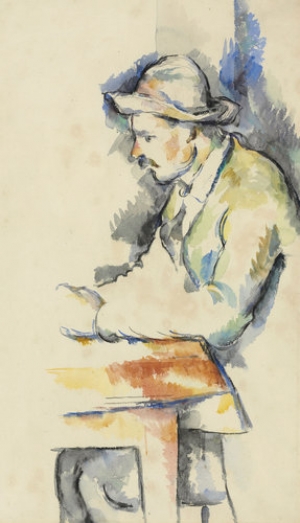
New collectors and old poured into Christie’s Rockefeller Center sales room on Tuesday night for the start of the big spring auctions. They may have come hoping for fireworks but instead sat through an anemic sale devoid of the kind of suspense and sky’s-the-limit bidding that can give these big-money evenings their excitement.
One reason was obvious: of the two auctions this week, Christie’s had far weaker material, with nothing to rival the attention-getting power of Munch’s famed pastel of “The Scream,” which is to come on the block at Sotheby’s on Wednesday.
“A number of people who have been in the market steadily over the last decade were bidders, and some who have only recently returned after dropping out for several years,” said Marc Porter, chairman and international head of private sales at Christie’s, adding that for the most part, the night’s buyers came from “traditional markets — America and Europe.”
The sale, which had been estimated to bring $90.5 million to $130.2 million, drew just over $117 million. Of the 31 lots offered, only three failed to sell.
(Final prices include the buyer’s commission to Christie’s: 25 percent of the first $50,000; 20 percent of the next $50,000 to $1 million and 12 percent of the rest. Estimates do not reflect commissions.)
Christie’s did have its own historically significant image, also a work on paper, but more of interest to connoisseurs than a trophy hunter who might try to snap up “The Scream.” It was “Card Player,” a watercolor by Cézanne of Paulin Paulet, a gardener on the estate of the artist’s family near Aix-en-Provence. A study for the artist’s famous “Card Players” series, it depicts Paulet absorbed in a game of cards. Three bidders competed for it, two on the telephone and a mystery man sitting glued to his cellphone in the second row. It was he who bought the watercolor for $17 million, or $19.1 million including Christie’s fees, just shy of its $20 million high estimate.
Where the watercolor will be heading is as unclear as where it was for nearly six decades, when scholars knew it just from black-and-white photographs. It was only recently discovered in the Dallas home of Dr. Heinz F. Eichenwald, a prominent collector who died in September.
One of the night’s few moments of passionate bidding occurred when “The Peonies,” a Matisse still life on the cover of the sale catalog, was bought by an unidentified European telephone bidder for $19.1 million. Painted in the summer of 1907 while the artist was vacationing in Collioure, a remote fishing village in southwest France, the colorful bowl of flowers had been estimated to fetch $8 million to $12 million.
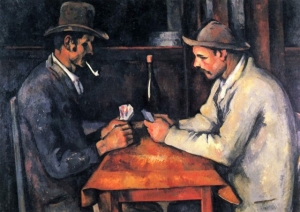
The tiny, oil-rich nation of Qatar has purchased a Paul Cézanne painting, The Card Players, for more than $250 million. The deal, in a single stroke, sets the highest price ever paid for a work of art and upends the modern art market.
If the price seems insane, it may well be, since it more than doubles the current auction record for a work of art. And this is no epic van Gogh landscape or Vermeer portrait, but an angular, moody representation of two Aix-en-Provence peasants in a card game. But, for its $250 million, Qatar gets more than a post-Impressionist masterpiece; it wins entry into an exclusive club. There are four other Cézanne Card Players in the series; and they are in the collections of the Metropolitan Museum of Art, the Musée d’Orsay, the Courtauld, and the Barnes Foundation. For a nation in the midst of building a museum empire, it’s instant cred.
Is the painting, created at the cusp of the 20th century, worth it? Well, Cézanne inspired Cubism and presaged abstract art, and Picasso called him “the father of us all.” That said, “$250 million is a fortune,” notes Victor Wiener, the fine-art appraiser called in by Lloyd’s of London when Steve Wynn put his elbow through a Picasso, in 2006. “But you take any art-history course, and a Card Players is likely in it. It’s a major, major image.” For months, he said, “its sale has been rumored. Now, everyone will use this price as a point of departure: it changes the whole art-market structure.”
The Cézanne sale actually took place in 2011, and details of the secret deal are now coming out as a slew of V.I.P. collectors, curators, and dealers head to Qatar for the opening next week of a Takashi Murakami blockbuster that was recently on view in the Palace of Versailles. The nation, located on its own small jetty off the Arabian Peninsula, is a new destination on the art-world grand tour: current exhibitions include an 80-foot-high Richard Serra and a Louise Bourgeois retrospective (her bronze spider is crawling across the Doha Convention Center), and in March it hosts a Global Art Forum that attracts artists, curators, and patrons from museum groups worldwide.
Land of the 1 Percent
Qatar (and its capital city, Doha) isn’t just a destination for those with private jets. It’s also a burgeoning intellectual and media hub. It hosts the headquarters of Al Jazeera, the Mideast campuses of Georgetown, Texas A&M, and Northwestern Universities—and of one the most ambitious sets of cultural goals since the robber barons and empire builders of America founded so many grand institutions a century ago.
Qatar does big things in a spectacular way. In 2008 when it opened the Museum of Islamic Art, a grand limestone behemoth by I. M. Pei, a flotilla of vintage ships sailed in V.I.P. guests representing the world’s great museums. Later, Robert De Niro floated up from the sea in a revolving open-air elevator to announce the Tribeca Film Festival was starting a Doha outpost.
In 2010, Qatar opened its Arab Museum of Modern Art, and the Qatar National Museum, currently closed for renovation by superstar architect Jean Nouvel, will reopen in 2014. That’s where the Cézanne could end up, flanked by some famous Rothkos, Warhols, and Hirsts that the Qataris have been snapping up in a buying spree.
The royal family of Qatar, does not comment on its purchases, however. And the tight circle of auction, houses, officials and dealers it is involved with, by and large, sign confidentiality agreements. But multiple sources confirm the record purchase of The Card Players.
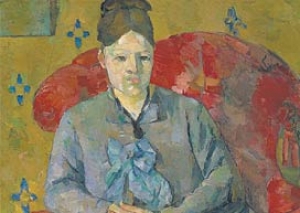
“I won’t offer you my hand, Monsieur Manet. I haven’t washed for eight days.” With such calculated incivilities, Cézanne invented himself as Impressionism’s bit of rough – the uncouth provincial who disdained Paris and retreated as solitary genius to commune with the Montagne St Victoire in his native Aix-en-Provence. A legend was born and sustained; refined and made scholarly, it reached its apotheosis in Aix’s landmark exhibition Cézanne in Provence in 2006.
But the greatest artists have multiple, contradictory facets and inevitably that show demanded an answer. The impressive new Cézanne et Paris at the Musée du Luxembourg relates how Cézanne spent more than half his working life in the French capital, studied there – his clumsy, agonised copies of Rembrandt and Delacroix in the Louvre are illuminating – and made the difficult trip to and from the Midi at least 20 times. This Cézanne set out not to work alone but to change the course of modern art, trump his peers and “astonish Paris with an apple”.
He followed his childhood friend Emile Zola north in 1861, met Renoir and Pissarro, but stood apart from the Impressionists immediately. In “La Rue des Saules, Montmartre”, painted when he was 28, the houses on a semi-rural street already suggest geometric cubes, colour is muted, the composition dominated by a broad grey pavement and echoing grey clouds. A decade later, in “Les Toits de Paris”, Cézanne drew the view from his fifth-floor Montparnasse studio in three stark horizontal bands to give the impression of depth of space: a massive zinc roof close up; then an expanse of red roofs touched with white, beige and chestnut; finally a heavy low sky – a sombre interpretation of the 19th-century City of Light that has little in common with Monet’s or Pissarro’s glittery, bustling Parisian society on bridges and boulevards.
Privately owned and rarely seen, Cézanne’s quiet, unpeopled visions of Paris introduce a show of surprises and iconic pieces, where almost every work is a masterpiece, with provenances – the Havemeyers, the Russian Morozov, early French collectors Théodore Duret and Victor Chocquet – to match.
Most were originally bought from Ambroise Vollard, whose towering likeness dominates a range of portraits – Zola, Pissarro, an unusually colourful portrait of Chocquet melting into a tapestry of rugs, paintings and marquetry – that bears witness to Cézanne’s close relationship with the Parisian avant-garde.
Vollard posed 115 times for a portrait Cézanne never conceded as finished. Everything about its restless surface marks – the suit folding in on itself, tight lips, shadowy downcast eyes – make this a depiction of interiority and intellectual enquiry, suggesting the intensity of the encounter between dealer and artist, with subtle highlights – on the knuckles, on Vollard’s massive brow – emphasising concentration and tension.
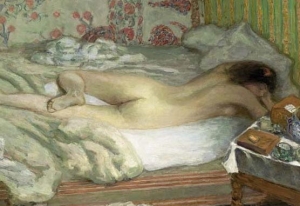
When Gertrude Stein published The Autobiography of Alice B. Toklas in 1933, all hell broke loose. Her hugely entertaining memoir tells the story of her early years in Paris, when her apartment in the rue de Fleurus became the most celebrated literary and artistic salon of the 20th century.
Readers were gripped by accounts of Gertrude’s Saturdays when visitors mingled with avant-garde artists, writers and collectors in rooms hung from floor to ceiling with the paintings by the artists she collected and promoted – including Renoir, Gauguin, Cézanne, Toulouse-Lautrec Matisse, Picasso and Juan Gris.
Her account of those years became an instant bestseller, but within the Stein family circle its publication caused consternation. For in it, Gertrude implied that she alone discovered Matisse and Picasso, downplaying the contribution of her two brothers Leo and Michael, and of Michael’s wife Sara. In truth, the four siblings acquired no fewer than 180 works by Matisse and Picasso alone, and all four were equally generous in providing financial and moral support to unknown artists. Leo was particularly scathing about the way his self-promoting sister wrote him out of the story. “Practically everything that she says of our activities before 1911 is false both in fact and implication… God what a liar she is!”
The massive exhibition devoted to the Stein Family that opens tomorrow at the Grand Palais sets the record straight. As the show documents in works of art, written and spoken words and scores of photographs, the Steins may not have been midwives at the birth of modern art, but they were certainly in the delivery room. What’s more, by admitting into their Saturday soirées anyone, whether they were interested in progressive painting or not, the Steins did as much as anyone to promote the culture of modernism. In the years when Picasso did not exhibit publically, the only way to see his work was to show up at an evening either with Gertrude and Leo in the rue de Fleurus or with Michael and Sara around the corner in the rue Madame. Matisse’s colour-saturated portraits and landscapes looked much less alarming when seen in a domestic setting, hanging alongside Renoirs or Gauguin, than they did in the scrum of the Salon d’Automne.
An educated, upper middle-class family originally from Pennsylvania, the Steins had money, but not a great deal of it, and were Jewish, but not religious. It was Leo who set the ball rolling when in 1902 he settled in Paris after two years studying art history in Florence. Shy and introspective, he was the driving force behind the collection and was able to recognise the ways in which young artists built on the achievements of the giants of French art in the 1870s such as Degas, Renoir, Cézanne and Manet.
This is could see that Picasso’s Boy Leading a Horse looked back to Cézanne’s Bathers, and Matisse’s Blue Nude, Memory of Biskra (1907) to the reclining nudes of Giorgione and Titian by way of Manet’s Olympia. It was Leo who (with Gertrude) bought Cézanne’s Woman with a Fan and he who acquired masterpieces from Picasso’s blue and rose periods. Leo defied conventional taste to purchase Matisse’s Lady in a Hat from the Salon d’Autumne of 1906 – not to mention owning the same artist’s Joy of Life, now in the Barnes Collection. Little wonder that Alfred Baar, the first director of the Museum of Modern Art, said of Leo that “for the two brief years between 1905 and 1907 he was possibly the most discerning art collector in the world”.
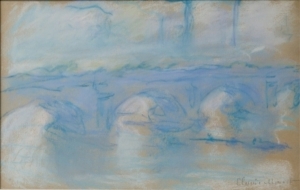
Trinity House Paintings, will unveil Claude Monet’s ‘Waterloo Bridge’ at the private view of their New York gallery opening and inaugural exhibition: ‘From Constable to Cézanne | Inaugural Exhibition by Trinity House Paintings NY’ on October 19, 2011, 6:30-9:00 PM at 24 East 64th Street.
Simon Shore is delighted to be opening the new gallery in New York “with Monet’s pastel sketch of London’s Waterloo Bridge. It has such an interesting place in the story of Impressionist art, but it is also particularly appropriate for our New York opening as an illustration of a London landmark. The gallery in New York will show case some of our most important works as well as ensuring that Trinity House can provide a more attentive service for our American based clients.”
‘Waterloo Bridge’, executed by Monet in January, 1901 from room 618 on the 6th floor of London’s celebrated Savoy Hotel, the drawing is one of only 26 pastels of the River Thames to survive from this period and the only example currently available on the open market. All other versions are held in museum collections.
Monet arrived in London in January 1901 and stayed (as he always did) at the Savoy. From this exclusive hotel, he could look right onto Charing Cross Bridge and left to Waterloo Bridge. He intended to paint the Thames in oil on canvas, however, frustratingly for Monet and fortunately for today’s collectors, his paints, brushes and canvases did not arrive. He found himself, unable to work. In despair he wrote to his wife Alice and complained his luggage was missing and he resorted to working at "many pastels" describing them as being "like exercises" preparing him for the task ahead. A week after his arrival in London his artist’s materials arrived and he conceded that things had gone well; "It is thanks to my promptly made pastels that I saw what I had to do."
The exhibition will feature a selection of important British paintings by John Constable, Sir Edwin Henry Landseer, Alfred Munnings and a work by George Stubbs once owned by the great American art collector, Paul Mellon. Claude Monet’s view of ‘Waterloo Bridge’ will also be exhibited alongside works by other Impressionist and Post-impressionist artists such as Paul Cézanne, Jean-Baptiste-Camille Corot and Eugène Boudin.
An important work that was to be included in this inaugural exhibition is “Préparation en dedans”, a charcoal on paper drawing by Edgar Degas (1834-1917) which at the request of the Royal Academy has gone on loan to be included in heir autumn blockbuster show, Degas and the Ballet; Picturing Movement (17 September-11 December 2011).
Guests invited to the opening of Trinity House Paintings New York gallery based at 24 East 64th Street will be treated to a quintessentially British affair, with valets sporting bowler hats and Savile Row tailoring and waiters plying them with English fare. If the weather holds true to British expectations, there will even be elegant union jack umbrellas at hand for the journey home.
Following on from their successful move to the heart of Mayfair Maddox Street, London in 2010, Trinity House Paintings has and will continue to exhibit at the world’s top art fairs, including Masterpiece in London, International Fine Art Fair New York and the American International Fine Art Fair Palm Beach.
The gallery will be open from September 15 -16, 2011 leading up to their inaugural exhibition ‘From Constable to Cézanne | Inaugural Exhibition by Trinity House Paintings NY’, private view October 19, 2011 6:30-9pm.
|
|
|
|
|